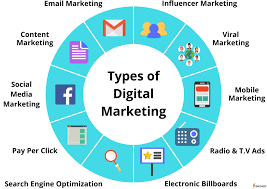what is the types of digital marketing
8/20/20254 min read


Digital Marketing Strategies: A Complete Guide
In today’s fast-changing world, businesses cannot rely only on traditional marketing like TV ads, posters, or newspapers. Most customers are online, whether on search engines, social media, or mobile apps. This is where digital marketing plays a crucial role. It helps businesses reach the right people at the right time with measurable results.
But what exactly are digital marketing strategies? Let’s explore the most important ones in detail.
1. Content Marketing
Content marketing focuses on creating valuable content such as blogs, articles, videos, or infographics that solve customer problems. Instead of directly selling, this method builds trust and long-term relationships.
Advantages: Improves brand authority, boosts Google ranking, generates organic traffic.
Disadvantages: Requires time, effort, and consistency to see results.
2. Search Engine Optimization (SEO)
SEO is the process of optimizing a website so that it ranks higher on search engines like Google. For example, if someone searches “best travel packages” and your travel website appears on the first page, it means your SEO is effective.
Advantages: Long-term visibility, free website traffic, brand credibility.
Disadvantages: Competitive, results take time, frequent algorithm changes.
3. Social Media Marketing
Social media platforms such as Facebook, Instagram, and LinkedIn allow businesses to connect directly with their audience. Companies can share updates, engage with followers, and even run paid advertisements.
Advantages: Wide reach, affordable promotions, builds community engagement.
Disadvantages: Needs continuous posting and creative content to remain effective.
4. Pay-Per-Click (PPC) Advertising
PPC ads appear on Google or social platforms. Businesses only pay when users click on the ad.
Advantages: Quick results, highly targeted campaigns.
Disadvantages: Can be expensive, traffic stops when ads stop running.
5. Affiliate Marketing
In affiliate marketing, businesses partner with individuals or websites to promote products. Affiliates earn a commission on each sale generated through their links.
Advantages: Low upfront cost, extended reach.
Disadvantages: Income depends on sales, chances of fraudulent practices.
6. Mobile Marketing
With the majority of people using smartphones, mobile marketing includes SMS campaigns, app notifications, and mobile-friendly websites.
Advantages: Direct customer reach, measurable performance.
Disadvantages: Customers may ignore messages or block ads.
7. Email Marketing
Email marketing is one of the oldest yet most effective strategies. Businesses send promotional messages, newsletters, or offers directly to customers’ inboxes.
Advantages: Cost-effective, personal communication, strong return on investment.
Disadvantages: Requires a quality email list, some emails may go to spam.
8. Influencer Marketing
Brands collaborate with influencers to promote their products. Influencers have established trust with their audience, which makes their recommendations powerful.
Advantages: Builds quick trust, effective for niche markets.
Disadvantages: Can be expensive, depends on influencer authenticity.
9. Video Marketing
Video is one of the most engaging forms of content. Platforms like YouTube, Instagram Reels, and TikTok have made video marketing essential.
Advantages: High engagement, strong storytelling impact.
Disadvantages: Requires creativity, editing skills, and consistency.
In today’s fast-changing world, businesses cannot rely only on traditional marketing like TV ads, posters, or newspapers. Most customers are online, whether on search engines, social media, or mobile apps. This is where digital marketing plays a crucial role. It helps businesses reach the right people at the right time with measurable results.
But what exactly are digital marketing strategies? Let’s explore the most important ones in detail.
1. Content Marketing
Content marketing focuses on creating valuable content such as blogs, articles, videos, or infographics that solve customer problems. Instead of directly selling, this method builds trust and long-term relationships.
Advantages: Improves brand authority, boosts Google ranking, generates organic traffic.
Disadvantages: Requires time, effort, and consistency to see results.
2. Search Engine Optimization (SEO)
SEO is the process of optimizing a website so that it ranks higher on search engines like Google. For example, if someone searches “best travel packages” and your travel website appears on the first page, it means your SEO is effective.
Advantages: Long-term visibility, free website traffic, brand credibility.
Disadvantages: Competitive, results take time, frequent algorithm changes.
3. Social Media Marketing
Social media platforms such as Facebook, Instagram, and LinkedIn allow businesses to connect directly with their audience. Companies can share updates, engage with followers, and even run paid advertisements.
Advantages: Wide reach, affordable promotions, builds community engagement.
Disadvantages: Needs continuous posting and creative content to remain effective.
4. Pay-Per-Click (PPC) Advertising
PPC ads appear on Google or social platforms. Businesses only pay when users click on the ad.
Advantages: Quick results, highly targeted campaigns.
Disadvantages: Can be expensive, traffic stops when ads stop running.
5. Affiliate Marketing
In affiliate marketing, businesses partner with individuals or websites to promote products. Affiliates earn a commission on each sale generated through their links.
Advantages: Low upfront cost, extended reach.
Disadvantages: Income depends on sales, chances of fraudulent practices.
6. Mobile Marketing
With the majority of people using smartphones, mobile marketing includes SMS campaigns, app notifications, and mobile-friendly websites.
Advantages: Direct customer reach, measurable performance.
Disadvantages: Customers may ignore messages or block ads.
7. Email Marketing
Email marketing is one of the oldest yet most effective strategies. Businesses send promotional messages, newsletters, or offers directly to customers’ inboxes.
Advantages: Cost-effective, personal communication, strong return on investment.
Disadvantages: Requires a quality email list, some emails may go to spam.
8. Influencer Marketing
Brands collaborate with influencers to promote their products. Influencers have established trust with their audience, which makes their recommendations powerful.
Advantages: Builds quick trust, effective for niche markets.
Disadvantages: Can be expensive, depends on influencer authenticity.
9. Video Marketing
Video is one of the most engaging forms of content. Platforms like YouTube, Instagram Reels, and TikTok have made video marketing essential.
Advantages: High engagement, strong storytelling impact.
Disadvantages: Requires creativity, editing skills, and consistency.
